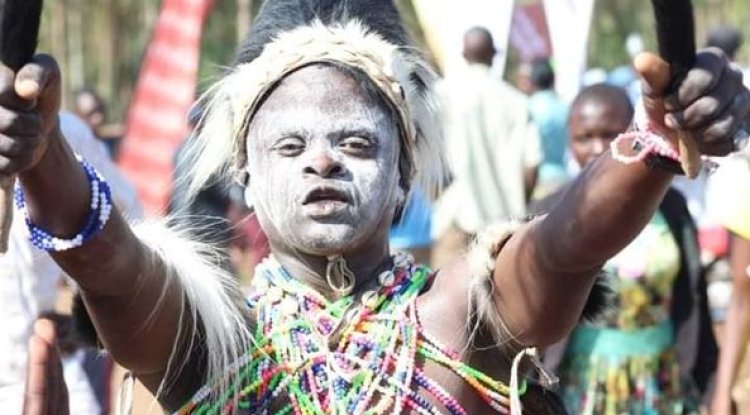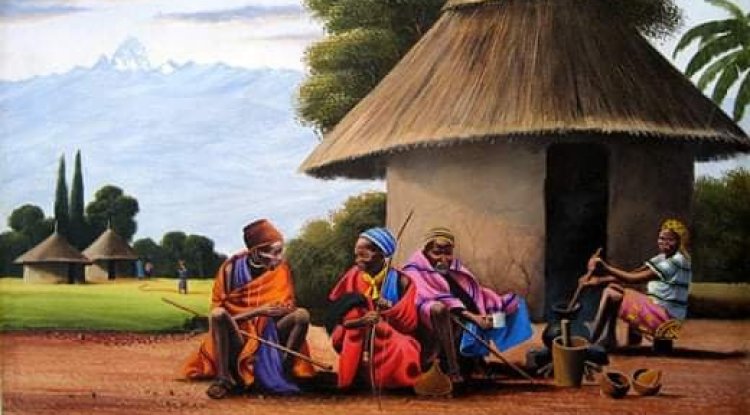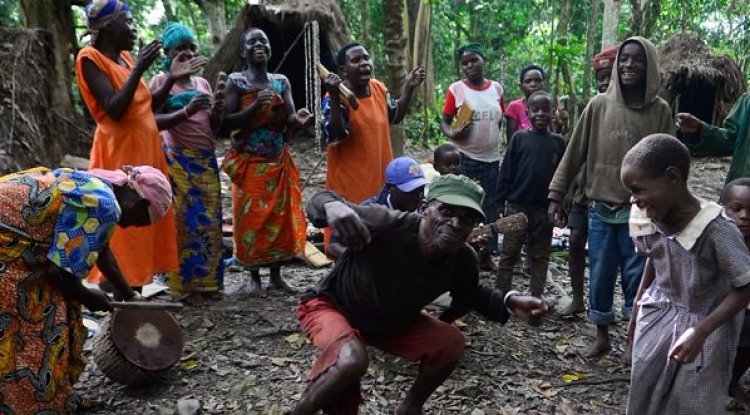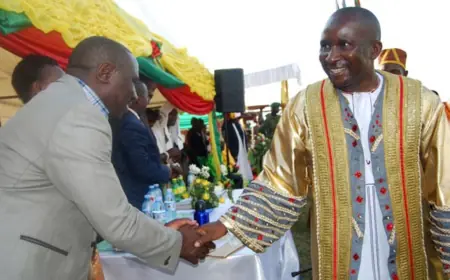THE MADI (Ma'di)
The Madi live in the Moyo district in the extreme north, bordering Sudan. They are Sudanic in language and their origin could be traced to Bari in Southern Sudan.
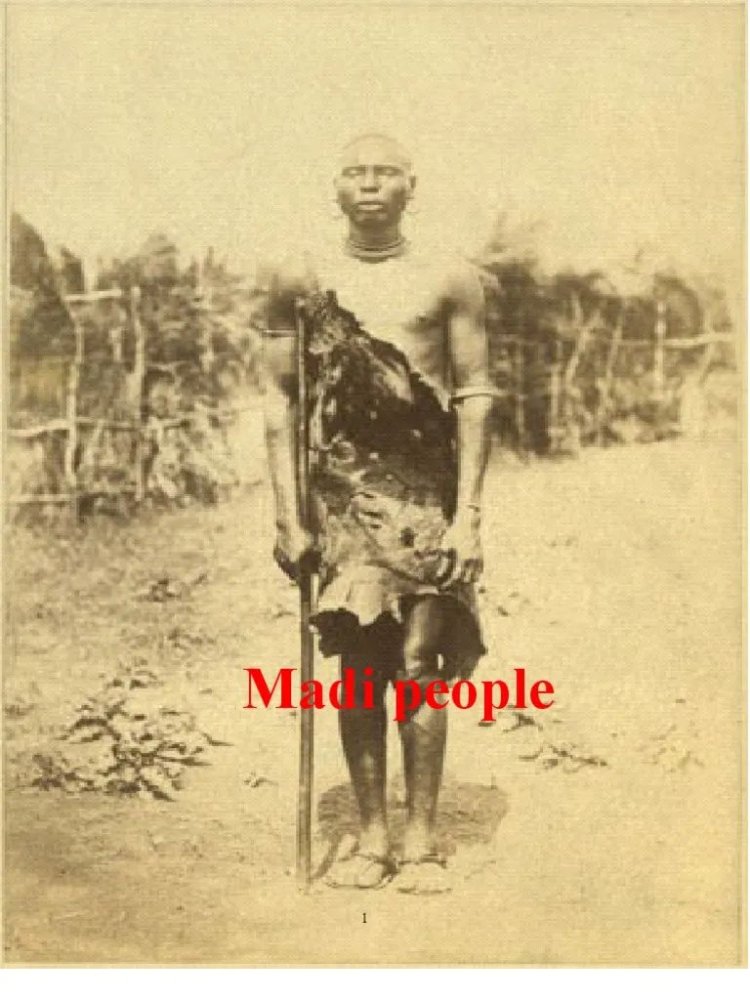
The Pageri County in South Sudan and the Ugandan districts of Adjumani and Moyo are home to the Mà'd people. The region stretches from Nimule, at the border between South Sudan and Uganda, to Nyolo River, where the Ma'di mix with the Acholi, the Bari, and the Lolubo. It crosses the River Nile from Parajok/Magwi to Uganda, running east to west.
Where the Nile River sharply curves into Uganda, in the southwest of Torit district, is where the Madi people live. They can be found in the Moyo and Adjumani districts of Uganda's west Nile.
Madi's language
The speakers go by the name Madi and address themselves. This is spelled Ma'di; the apostrophe denotes that the d is implosive. The term "madi ti," which means "Ma'di mouth," is used to describe the speakers' native tongue. Ma'di identify one another as being members of a suru (a "clan" or "tribe"), which can be further split down to pa (the descendants of), which can occasionally overlap with suru. While a Madi can only wed someone outside their clan, they often wed someone else who speaks the same language as them.
A Brief History of Madi
Etymologies about 'Ма 'di'
One well-known folktale claims that the term Madi originated in response to a question posed by a white guy to a Madi man. The bewildered reply to "who are you?" from the first white person in the area was "madi," which is another word for "a person." This was assumed to be the people's name, and it has since become corrupted.
The names of several of the Moru-Ma'di group members are explained in another Ma'di narrative. When the Ma'di's ancestors were forced southward, they said, "Let's construct a settlement here," or Muro-Amadri, when they arrived at a key area. In order to defend themselves, they grouped together. The Moru name was given to this group. In a more-or-less starving state, a group split out in quest of greener pastures. Eventually, they discovered an edible tree known as lugba (also known as "desert dates" or ximenia aegyptiaca).
They took some of the fruits with them after they had eaten some of them. When it was time to restock their tummies, they overheard a woman who had lost her harvest asking about the lugba ri, or "the desert dates." Although the Ma'di continue to refer to this group as lugban, they are now known as logbara. When the last group arrived at fertile terrain, they made a decision and said, "Here I am (at last)!" These individuals became known as the Ma'di.
Early history
According to Ma'di oral history, Nigeria is where the Ma'di people originated. The Ma'di people left Nigeria and traveled south until they arrived in Amadi, a town in southwest Sudan, where they established, according to one often repeated oral account. In Ma'di, the phrase "Amadi" means "here we are." It also denotes where we are. The Ma'di and Moru were still one ethnic group at that time, according to this plot.
The Ma'di people traveled east from Amadi to reach the River Nile. There, they were divided into the Moru and Ma'di groupings. The Ma'di cluster settled beside the riverbed while the Moru cluster turned around and moved westward. It is thought that a dispute over a peanut caused the two clusters (groups) to split apart. Groundnuts were uncovered by a Ma'di guy, who consumed them by himself. His Moru brother distanced himself from him after accusing him of being avaricious.
However, the Ma'di oral history of today is unable to identify the time frame of Ma'di's migration from Nigeria to Sudan. Additionally, it is unable to fill up the historical gap between the Ma'di of today and their presumed forebears, the Nigerians. There are several perspectives on Ma'di's genesis among researchers who are not from Ma'di. The Ma'di people most likely arrived in the southern Sudan region between 140 and 1700 A.D., yet their origins have remained a mystery. The Nilotic people moved from the north to the south at this time.
According to one Ma'di oral history account, certain Ma'di tribes made their homes close to Mount Rajaf, near the Nile, when the Ma'di and Moru split. South of Rajaf, at Nyarabanga, others made their homes. They mixed with Bari people in those locations. The Ma'di people spent many years residing in Rajaf. As they multiplied, they split up into smaller groups, and many of them departed Rajaf. Many people have traveled south over the years along various routes in search of better places to live. Arapi, Goopi (Logopi), Logili, Mugi, Okei, Pandikeri, Patibi (Moi-ba), and other groups had name changes as they progressed.
The Madi migration to Uganda
It was simply a matter of time before the Tukutuku conquered the Ma'di people, given their superior military prowess and the help they received from the indigenous (who joined them). The people of Ma'di were made to scatter. Others traveled further south, to Uganda, while others ventured further into the jungles. Less fortunate people were grabbed and taken away. Some of those who were captured later became Tukutuku army recruits, while others worked as laborers.
Some Tukutuku moved further south and established bases in Uganda once the Tukutuku tribe's foundation in Sudan was solidified. A group of Tukutuku camped in Odrupele, Uganda (Lebubu). Emin Pasha, the commander of the Tukutuku, forced the Madi and other ethnic groups (whom he enrolled into his army) to construct a fort. The fort was finished in 1879 and is now known as Dufile Fort. The fort is situated in Uganda along the Albert Nile. The Ma'di people supplied a large portion of the laborers that erected the fort. Today, most Madi people reside in Moyo, Oodrupele.
Births the culture of Madi
The Madi had a tendency to find the mystery of birth troubling. Their entire worldview was predicated on reproduction. In their language, the Supreme Being in charge of births was referred to as Rabanga. Rabanga was seen as a spirit as well as the earth, or "Mother Earth," in the traditional meaning. We know that all plants are born from the soil, so how does a woman become pregnant if the earth cannot make her fertile?, said one elderly guy in his explanation of this idea. It was also thought that Rabanga had created everything.
Twins
The Madi regarded the birth of twins as a bad omen and attributed it to Rabanga. Twins were thought to be enigmatic beings; in fact, the elder twin's name was Ejaiya, which means "send him to the bush," while the younger twin's name was Rabanga. Following the birth of twins, the mother's family and the father's families would each contribute a sheep, which would be shared by the twins' parents and the woman who had cared for the mother of the twins during her confinement. Lati was the name of this ritual.
Every morning and evening, a new sheep from the mother's family had to be brought in and tied in a bed-like arrangement at the mother's slide. With the exception of the mornings and nights when it was placed on the bed, the sheep was allowed to live a typical life with the other sheep. It was slain and sacrificed as a sacrifice after giving birth in order to protect the twins' parents. The sheep itself was referred to as Rabanga-Bilo, as was the particular stick bed on which it was frequently placed.
Madi's Religious beliefs
The Madi lived their entire lives under the assumption that their ancestors continued to exist after death as ori spirits. They thought the Ori had direct access to human affairs. In the event of any tragedy or illness, they would instantly consult an odzo or odzogo (witch doctor) to determine which ancestor was responsible for the current ordeal. They believed that misfortune was caused by the wrath of such and such a spirit. Then sacrifices were made to the specific spirit to counteract its negative impact on the living. The powerful Madi families were said to have strong ancestor spirits to aid them. Babu-garee was the name given to the entire collection of dead people's spirits' possessions.
Christianity
The Madi people were split into the Madi of Uganda and the Madi of Sudan. Due to the fact that colonialism and Christianization were inextricably linked, Christianity was introduced to the northern section of Lado Enclave via Uganda in about the same period.
The idea of God and the Madi name for it, Rubanga, are relatively modern concepts. They brought the Christian faith. For instance, we are obliged to respond Rubanga ido oluka ku to the question Rubanga ido oluka adu nga (How old is God) in the Roman Cathotic Catechism in Madi (God has no beginning). You are meant to respond Rubanga obi mani obama vu dri ni to the question Adi obi nyi ni oba nyi vu dri ni (who made you and placed you on the Earth) (God has created me and put me on Earth). Additionally, ta Rubanga abi le ati ri anjeli is demanded of us (the first things God created were angels).
If you travel back in time and depart from the Christian worldview, you arrive in Benoniga. The concepts of time and space are meaningless and empty since there was nothing before that. Thus, all events and creation occurred after the creation of Beroniga, and vu (space-time) arrived along with Beronigo.
Without the backdrop of Christianity, Rubanga obi vu ni does not exist in Madi cosmogony. That is impossible since vu (space-time) was created by Beringa, whereas Rubanga brought Christianity to Madi. Giving vu the attribute of kindness when it lacks it is likewise incorrect. The Ori always had the upper hand over Vu (the spirit gods). Trees, snakes, rivers, hills, or the souls of departed parents and relatives are frequent manifestations of the ori, both benign and harmful. While the tree god and the river god may pass away, the ori that gave those beings their virtues never passes away because they reincarnate. The Madi people worshipped ori at kidori (stone altars). In Madi, worship is called kirodi di ka (or sometimes vu di ka). When the ori are happy with the people, they bless vu, and vu becomes friendly to the inhabitants.
Islam
While some Madi are still Muslims, Christians now make up the bulk of them. Anglicans and Catholics make up the majority of the Christian Ma'di. However, there are a ton of brand-new churches opening up all the time. In Uganda, there is also a substantial Muslim population, primarily Nubi, which is concentrated in commercial hubs like Adjumani, Dzaipi, and Nimule.
Rain making
There were up to 45 rain-making centers located throughout the whole Madi village. The rainmaker used a particular set of stones, typically white in color, to create rain, with only two exceptions. These "rain stones," as they were known, could be divided into "male" and "female" stones and were thought to fall from the sky with rain. The female stones would either be round or conical but possibly without sharp tips, whereas the male stones are conical with rather sharp points. In reality, some female stones appeared to be exactly like male stones, but the rain creator was able to distinguish between the two with ease.
"Rain stones" were found and reported to the chief without delay. It is reported that the "rain stones" would jump about during thunder or lightning. They were stored in special pots and could only be viewed with the chief's or rain maker's permission since otherwise they may easily and impotently hit the arrogant observer.
People would ask the rainmaker for help if the rain didn't fall as expected. The rainmaker's rainmaking ceremony was wholly bizarre. Prayers were offered to Rabanga and the past chiefs while the stones were covered in oil or fat. After eating the meal offered as an offering, the stones would be submerged in a small amount of water. The rainmaker entered the shelters containing the rain stones with the offertory food (mtami, wimbi, and beans) and shea-butter nut oil. Invoking the spirits of the deceased chiefs and Rabanga to send rain, he would then place the clay pot on a wooden basin, remove the "rain stones" from their pot, wash them, and place them in a bowl.
The only people who were supposed to attend the event were the rainmaker and the chief's principal woman. They would boil the beans in the oil and prepare beer from mtami and wimbi. Millet bread would also be produced from the remaining wimbi. The rainmaker and the two key women who prepared it ate this cuisine. The "rain stones" were then put in a container with just enough water—neither too much nor too little—to cover them. The rainmaker and the women refused to eat anything else or leave the hut the entire day. On that day, rain was anticipated.
Adzo would be consulted if rain didn't fall, or else the rainmaker would prolong the rain-making ritual to include butchering and eating a sheep. Rain was anticipated, unless something incredibly unnatural occurred. The rainmaker would choose a branch from a shrub called erewa, paint it with red ochre, and place it on the roof of the hut where the rain stones were kept if there was an excessive amount of rain.
According to legend, only two Madi tribes were capable of producing rain without the use of "rain stones". At their place of worship, the elders would gather and ask Rubanga to play with him to bring rain.
Superstitions
- A man would run back and seek advice from a witch doctor before continuing his journey if he encountered or saw a rabbit, bushbuck, or wild pig.
- Someone in the family would perish if an owl hooted while perched on one's house or if a man encountered a specific snake or leopard.
- The inhabitants would immediately relocate to a new location where the former house was cursed if a jackal barked inside their compound.
- There was also the notion that some humans have the ability to transform into leopards or to communicate with them in order to utilize them for nefarious purposes.
Political set-up
The Madi's political structure and religious outlook were closely related. They were divided into chiefdoms, and the Opi, a hereditary chef, oversaw each chiefdom. Both political and ecclesiastical authority were exercised by the Opi. He was revered both as a political leader and as the hub of the prior chiefs' combined authority.
In addition to the leaders, the rainmakers and the Vudipi also held political and even religious significance in the Madi society. The Vudipi had a significant impact on the country. It was believed that the chiefs, rainmakers, and Vudipi all descended from ancestors who carried out the same duties. They were also said to possess similar abilities even after passing away. A hierarchy of spirits existed that matched the social order's lines of authority to a T.
Judicial system
The witch doctor was called when someone was accused of stealing or adultery and they pled innocent. The complainant and the accused were instructed to hold each end of a spear of spear grass that the witch doctor had taken. The witch doctor would then use an arrow to cut the spear grass. Whoever was at fault would get sick, and the truth would come out as a result. The guilty party was typically absolved as follows:
He would purchase a sheep that would be killed. Both the accuser and the accused had the backs of their hands covered in blood and manure from the sheep's intestines. Additionally, their chests were covered in some blood and feces. The elders of the two households involved would then consume the meat of the sheep as a sign of reconciliation after their legs had been tied with the animal's skin.
The witch doctor would heat a spear and touch the accused person's leg with the hot end in cases involving poisoning. If a weal appeared, the accuser would be found guilty and executed right away with a spear. A weal would undoubtedly happen if one was grazed by a heated spear on the thigh, it seemed automatically. There are rumors that that didn't happen in some circumstances, though.
Economy
The Madi were sedentary farmers. Mtami, Wimbi, as well as a number of beans and shea butter, were their primary crops. They traded with their neighbors in a profitable manner and used the barter system as their primary method of exchange.
They also took care of hens, calves, sheep, and goats. Like the majority of pre-colonial Ugandan communities, their primary economic system was one of subsistence. A division of the Madi are the Metu people. They are located in West Madi, in the rugged and precipitous region to the west of Mount Otze. The higher Metu, also known as the Meturu, and the lower Metu, also known as the Meituli, are divided among them.
Dances
- Mure — the ecstatic and lamenting dance. It is frequently performed in both celebration (of occasions like a war victory, the birth of a king, etc.) and sadness (the death of a king, loss of land during war, etc.). Drums, timber trumpets (ture, odiri), animal horns (pkere, bila), dancing bells (mgbiri), and drum beats are frequently used to accompany mure dances (leri). Men occasionally bellow during the mure dance (sira soka). Each cira is distinct and conveys a secret message. A sira is typically employed as a symbol of authority and identification. Women would respond with their own bellow (Gbilili) as a mark of respect and acknowledgment (typically the wives of the men who utter cira). War songs (jenyi) are frequently sung during mure, notably
- Gayi — a flamingo-like youth flirting dance.
- Kore — a graceful dance
- Kejua — mainly performed by women
Important tourist attractions
Dufile in Uganda has significant remains of a fort that Emin Pasha erected in 1879 adjacent to a location chosen by Charles George Gordon in 1874. Originally used as a port for steamers, Dufile is now connected to Nimule by passenger ferries. The Nimule National Park and the Fulla Rapids in Sudan could both play a significant role in the region's hydroelectricity supply.
What's Your Reaction?
 Like
8
Like
8
 Dislike
0
Dislike
0
 Love
3
Love
3
 Funny
0
Funny
0
 Angry
0
Angry
0
 Sad
0
Sad
0
 Wow
3
Wow
3





























































